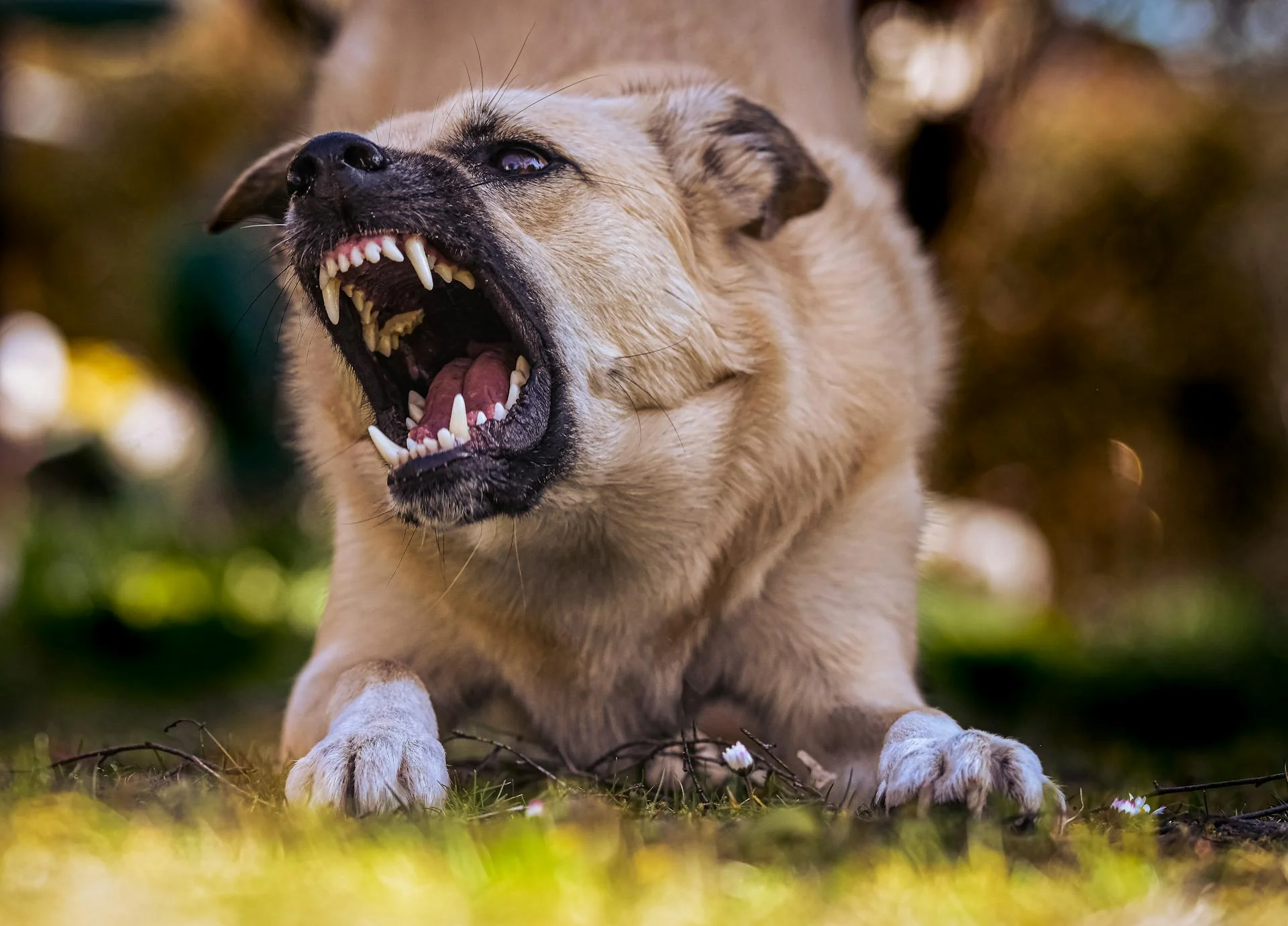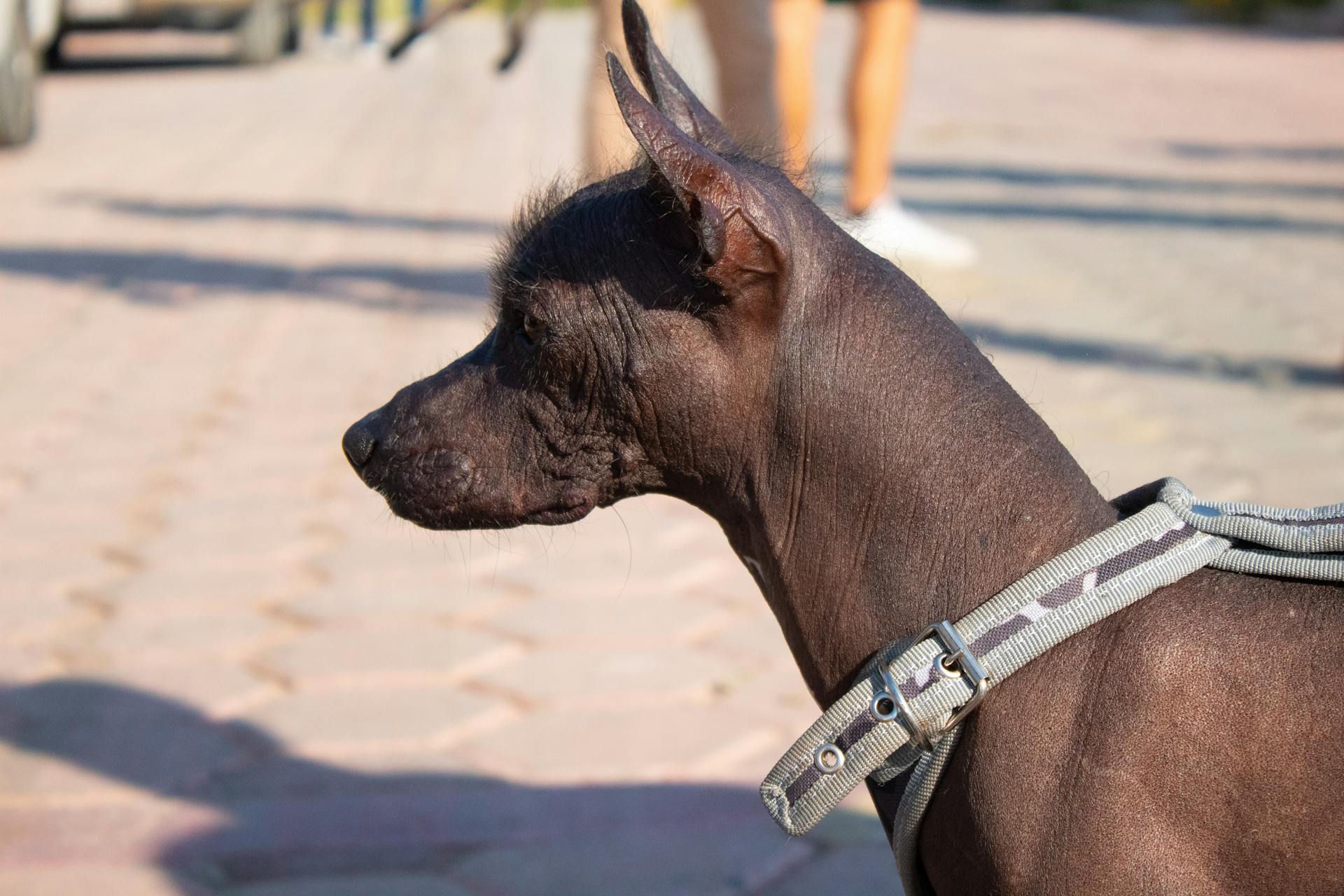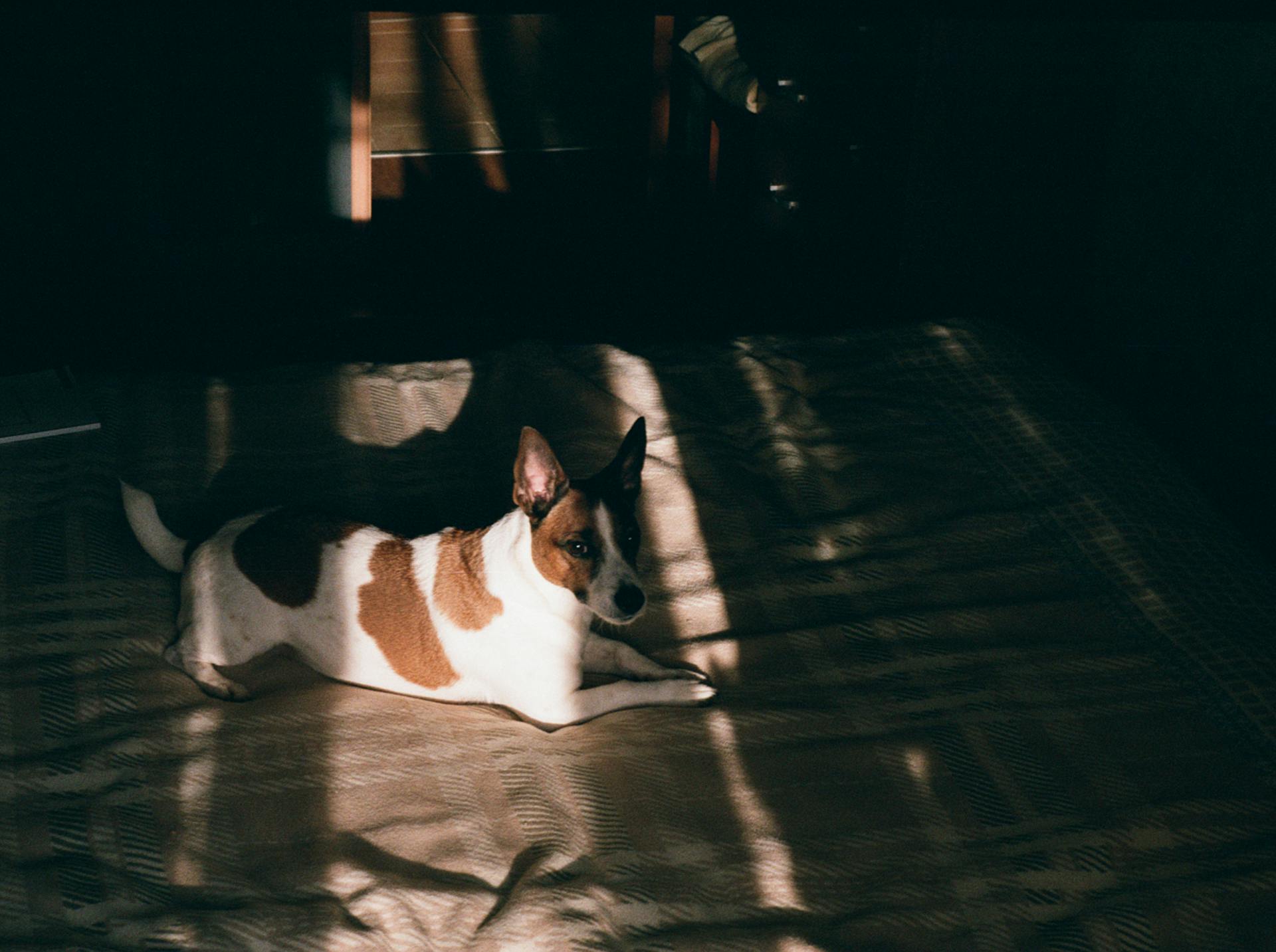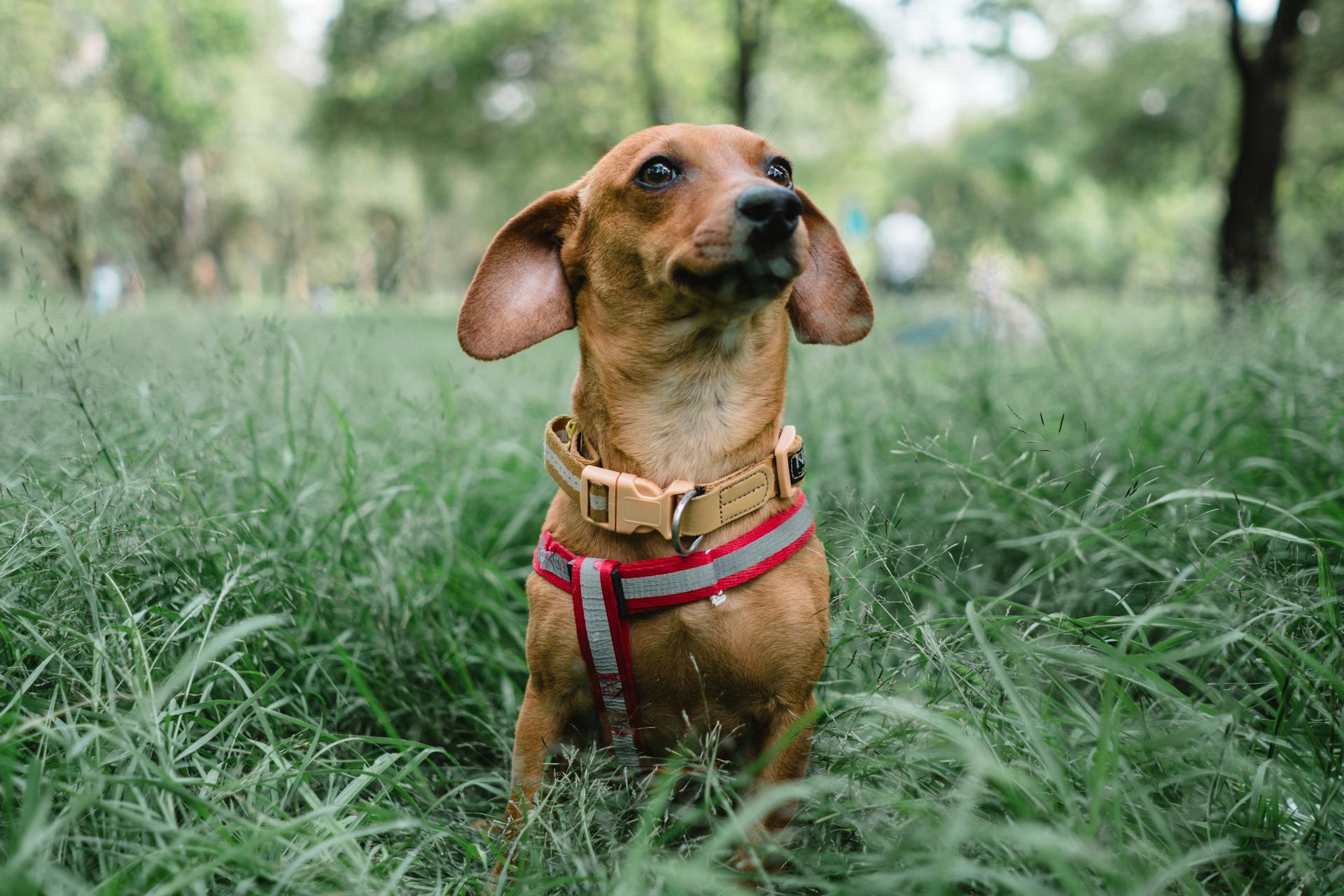
Dog aggression towards other dogs is a complex issue that can be caused by a variety of factors, including genetics, socialization, and past experiences.
Some dogs may be more prone to aggression due to their breed or genetic makeup, while others may have learned aggressive behaviors through interactions with other dogs or people.
A lack of proper socialization during a dog's critical period, typically between 8 and 11 weeks of age, can also contribute to aggression towards other dogs.
Dogs that are not socialized properly may become fearful or anxious around other dogs, leading to aggressive behavior.
With the right training and management, however, it is possible to reduce or even eliminate dog aggression towards other dogs.
By understanding the underlying causes of aggression and taking steps to address them, dog owners can help their pets feel more comfortable and confident around other dogs.
Consider reading: Dog Training Socialization
Causes and Understanding
Dog aggression towards other dogs is a complex issue with multiple causes. Aggression in dogs often stems from inadequate socialization, which can lead to a lack of understanding of appropriate behaviors around unfamiliar dogs.
Socialization is a critical period in a dog's life, and it's essential to expose puppies to various environments, people, and other dogs to help them develop good social skills. Dogs that haven't received proper socialization may become aggressive towards other dogs as a result.
Genetic factors can also predispose certain breeds or individual dogs to aggression towards other dogs. However, this doesn't mean that every dog with a certain breed or genetic makeup will exhibit aggressive behavior.
Early experiences, such as traumatic events or lack of proper care or training, can contribute to aggressive behaviors towards other dogs. This highlights the importance of providing a stable and nurturing environment for dogs to grow and develop.
Understanding the specific types of aggression your dog displays is crucial in addressing the behavior. Identifying the causes of aggression can help you develop effective strategies for prevention and management.
You might like: Does Cbd Help with Dog Aggression
Recognizing and Identifying
Recognizing the warning signs of potential aggression is vital for preventing injuries to people and other animals. Before a dog bites, it may show signs such as body stiffness, growling, lunging without making contact, showing its teeth, and snarling.
If this caught your attention, see: Signs of Prey Drive in Dogs
Most aggressive behaviors are triggered by specific stimuli and a lack of appropriate responses. Identifying your dog's triggers requires careful observation of their behavior and body language in various situations.
If your dog exhibits any of the following behaviors, they may have aggression issues: Barking, straining, biting, nipping, or lunging.Standing still and stiff with ears forward, mouth closed, tail high, hackles raised.Growling or baring teeth.Blocking paths of people or other dogs.Barging through doors or gates ahead of you.Demanding attention.Resource guarding.Mounting people’s legs or other dogs.Approaching another dog from the side and placing their head on the other dog’s back/shoulder.Inserting themselves between you and another person or dog.
Sometimes, dogs can be unpredictable and may bite without prior warning.
Preventing and Managing
Early socialization is crucial in preventing dog aggression towards other dogs. Socialization involves deliberate exposure to friendly dogs, but it's essential to do so when your puppy appears neutral or friendly.
Exposing your dog to well-trained dogs and various environments from a young age can help them become well-adjusted and confident. This can be done by enrolling your dog in training classes or daycare programs.
To prevent incidents, it's essential to recognize the warning signs of aggression in your dog, such as growling, snarling, or snapping. If you notice these signs, it's crucial to intervene before the situation escalates.
Here are some management strategies to consider:
It's also essential to consult with professionals, such as a veterinarian or a certified animal behaviorist, to develop an effective management plan tailored to your dog's specific needs.
Preventing Leash
You can prevent leash pulling by teaching your dog to walk by your side. This can be achieved by using positive reinforcement techniques such as treats and praise.
A good rule of thumb is to keep the leash loose and only tighten it when your dog starts to pull.
Dogs that are not spayed or neutered are more likely to engage in leash pulling due to hormonal imbalances.
Regular exercise can also help reduce leash pulling in dogs.
Leash pulling can be a sign of anxiety or excitement in dogs, so it's essential to identify the underlying cause to address the issue effectively.
Broaden your view: Dog Training Harness for Pulling
Preventing Lunging on Walks
Preventing lunging on walks is crucial to avoid any incidents with other dogs or people. Early socialization is key to helping your dog feel comfortable around other dogs.
Healthy small treats can be a lifesaver when your dog gets anxious around other dogs. Keep them handy when you go on a walk.
It's essential to recognize when your dog is getting into aggressive mode and use commands to prevent incidents before they happen. Consistently enforcing clear rules and boundaries can also help prevent confusion and frustration.
If your dog is already exhibiting signs of fear or aggression around other dogs, consult a behaviorist before attempting to socialize them further. Reward-based training can also help reduce the risk of aggression, but it's crucial to learn effective training methods from professionals.
Readers also liked: Can Neutering a Dog Help with Aggression
To calm an aggressive dog, it's essential to understand what they're communicating and address the reason behind the aggression, rather than meeting it with more aggression or punishment.
Here are some factors to consider when assessing your dog's aggressive behavior:
- Frequency/predictability: Does your dog exhibit aggressive behavior at specific times or situations?
- Duration: How long does your dog continue to exhibit aggressive behavior?
- Targets: Does your dog target specific people or dogs?
By understanding these factors, you can develop a plan to address your dog's aggressive behavior and prevent lunging on walks.
Treating
Treating dog aggression towards other dogs requires a comprehensive approach that addresses the underlying causes of the behavior. A thorough physical exam by a veterinarian is essential to rule out any underlying medical issues contributing to the aggression.
To identify triggers, keep a journal to track situations or stimuli that elicit aggressive responses in your dog. This will help you understand what sets your dog off and allow you to develop a tailored treatment plan.
Punishment-based strategies should be avoided, as they can increase the intensity of aggression and make it more challenging for your dog to relax and recover. Instead, work with a certified dog trainer or behaviorist to implement behavior modification techniques using positive reinforcement, desensitization, and other methods.
Medication may be added to the treatment program if your dog has been diagnosed with anxiety, hyperreactivity, or frustration intolerance. However, medication alone is not enough, and behavior modification is always necessary.
A tailored treatment plan should be developed by a certified dog trainer or behaviorist, taking into account your dog's specific needs and circumstances. This plan should include a combination of behavior modification techniques, environmental modifications, and training to help your dog overcome aggression.
Here are some key elements to include in your treatment plan:
- Identify triggers and develop strategies to avoid or manage them
- Implement behavior modification techniques using positive reinforcement and desensitization
- Modify your dog's environment to reduce opportunities for aggression
- Establish clear boundaries and rules, practicing consistency and positive reinforcement
- Be patient and consistent, celebrating progress and persisting in your efforts to help your dog overcome aggression
By following these steps and working with a certified dog trainer or behaviorist, you can help your dog overcome aggression towards other dogs and develop a more harmonious and peaceful relationship with other pets and people.
Calming and Reducing Aggression
Punishment-based strategies can contribute to an increased intensity of aggression and should be avoided. This means correcting your dog when they behave aggressively toward another dog can make things worse.
Identifying triggers for any aggressive response is essential so that appropriate management can be applied. Understanding the motivation behind your dog's behavior is key to applying the correct treatment.
Fear and anxiety are often treated with desensitization and counterconditioning. This involves identifying the point at which your dog appears uncomfortable and designing a behavior modification program to reduce their fear over time.
Reward-based training may also help reduce the risk of your dog developing aggression toward other dogs. This type of training helps you and your dog communicate effectively, making it easier to guide them away from other dogs if needed.
To calm an aggressive dog, it's essential to get a full picture of the behavior, including frequency, duration, and targets. This will help you understand the underlying causes of their aggression.
To prevent your dog from becoming aggressive with other dogs, early socialization is crucial. This involves deliberate exposure to friendly dogs, but only if your puppy appears neutral or friendly. If your puppy or adult dog is already exhibiting signs of fear or aggression, all attempts to socialize through further exposure should be discontinued.
Discover more: Shock Collar for Biting Puppy
Here are some key things to keep in mind when trying to calm and reduce aggression in your dog:
- Avoid punishment-based strategies, as they can increase aggression intensity.
- Identify and manage triggers for aggressive behavior.
- Use reward-based training to improve communication and reduce aggression risk.
- Get a full picture of the behavior to understand underlying causes.
- Discontinue socialization attempts if your dog is already exhibiting fear or aggression.
Seeking Help and Treatment
If you're concerned about your dog's aggression towards other dogs, seeking help and treatment is crucial. Consult a veterinarian to rule out any underlying medical issues that may be contributing to the aggression.
A thorough physical exam can help identify potential causes, such as pain or an underlying medical condition. If your veterinarian suspects a medical issue, you should address it before starting a behavioral treatment program.
A certified dog trainer or behaviorist can assess your dog's behavior and develop a tailored treatment plan. They can help you identify triggers that provoke aggressive behavior and implement behavior modification techniques to change your dog's emotional response.
To effectively treat aggression, it's essential to modify your dog's environment to reduce opportunities for aggression. This can be achieved by using tools such as baby gates, crates, or muzzles to minimize exposure to triggers.
Explore further: Heartworm Treatment Make
Establishing clear boundaries and being consistent is also crucial in treating aggression. Set clear rules and boundaries, and practice consistency in rewarding desirable behaviors and correcting undesirable ones.
Treating aggression requires time, patience, and consistency. Stay calm, celebrate progress, and persist in your efforts to help your dog overcome aggression.
Stopping and Preventing Aggression
Stopping and preventing aggression in dogs towards other dogs requires a thoughtful and multi-faceted approach.
First and foremost, it's essential to identify the triggers for your dog's aggressive behavior. This can be done by observing your dog's body language and behavior around other dogs, and taking note of any patterns or consistencies.
To prevent aggression, early socialization is key. Socialization involves exposing your puppy to friendly dogs and other environments from a young age, which can help them become well-adjusted and confident.
Reward-based training can also help reduce the risk of your dog developing aggression towards other dogs. This type of training focuses on positive reinforcement, such as treats and praise, to encourage good behavior.
Punishment-based strategies, on the other hand, can actually contribute to increased aggression and should be avoided. Instead, focus on creating a management strategy that prioritizes physical and emotional safety for all parties involved.
If your dog does exhibit aggressive behavior, it's crucial to address the underlying cause rather than just punishing the behavior. This might involve working with a qualified trainer or behaviorist to develop a customized plan.
Here are some key management strategies to consider:
- Change your path or adjust the time of day for walks to avoid dogs
- Use a basket muzzle if your dog has shown aggressive behavior while on leash walks
- Prevent interactions between your dog and other dogs, especially if they're trigger-based
- Keep your dog on a leash and ask others to do the same
By taking a proactive and compassionate approach to addressing aggression in dogs, you can help create a safer and more harmonious environment for all.
Managing Specific Issues
Dogs may become aggressive due to feeling the need to protect their owner when other dogs are around, so it's essential to recognize the signs of aggressive behavior.
Keep healthy small treats handy for situations like walks when your dog gets anxious around other dogs.
Resource guarding or possessive aggression can be challenging to treat, but removing valuables before allowing dogs to interact may be the best approach.
If your dog has predatory aggression or behavior, keeping them on a leash near other dogs, especially small dogs, is crucial for safety.
A unique perspective: Small Dog Aggression
Treating Predatory Behavior
If your dog has been diagnosed with predatory aggression or behavior, it's essential to keep them on a leash when other dogs are nearby, especially small dogs, for safety.
Treatment might include using response substitution to teach an alternative behavior, but aggressive behavior can never be entirely eliminated, so there's always some risk that the behavior will resurface.
A veterinarian should be consulted to rule out any medical issues contributing to your dog's aggression, and then a certified dog trainer or behaviorist can assess your dog's behavior and develop a tailored treatment plan.
To identify triggers, keep a journal to track situations or stimuli that elicit aggressive responses.
Here are some common triggers to consider:
- Small dogs
- Other animals
- Prey-like objects
Implementing behavior modification techniques with a professional can help change your dog's emotional response to triggers and encourage appropriate behaviors.
Treating aggression requires time, patience, and consistency, so stay calm, celebrate progress, and persist in your efforts to help your dog overcome aggression.
Managing Fears and Anxieties
It's essential to identify the triggers and context for your dog's fear-based response to address their anxiety effectively.
Dogs may become aggressive due to feeling the need to protect their owner when other dogs are around. The owner must become aware of when their dog gets into aggressive mode and use commands to prevent incidents before they happen.
To reduce your dog's fear and anxiety about other dogs, consider using desensitization and counterconditioning techniques. This involves identifying the point at which your dog appears uncomfortable and designing a behavior modification program to reduce their fear over time.
A slow pace is crucial in treatment, keeping your dog 'under threshold' to avoid frightening them during a session. You can start by minimizing the opportunity for your dog to observe and bark at other dogs passing by the house or yard.
Supervise your dog outdoors, keeping them on a leash if you expect dogs to pass by, to prevent them from rushing towards the fence barking. You can also use a gate or close curtains to block the windows with the best street view indoors.
Teaching your dog to move to a specific spot, such as a mat or dog bed, in response to the sight of a passing dog can be an effective response substitution technique.
Consider reading: What Treats to Use for Dog Training
Frequently Asked Questions
How to stop a dog from attacking another dog?
To stop a dog from attacking another dog, distract the dogs with an object or a diversion to separate them safely. If necessary, physically intervene to separate the dogs while keeping a safe distance from their mouths.
Sources
- https://k9uchicago.com/blog/why-is-dog-aggressive-towards-other-dogs/
- https://vcahospitals.com/know-your-pet/dog-behavior-problems---aggression---unfamiliar-dogs---treatment
- https://www.ancillaryk9.com/blog/understsanding-aggression-in-dogs-signs-your-dog-has-aggresion-issues
- https://www.petmd.com/dog/behavior/aggression-in-dogs
- https://www.animalhumanesociety.org/resource/aggression-dogs
Featured Images: pexels.com


